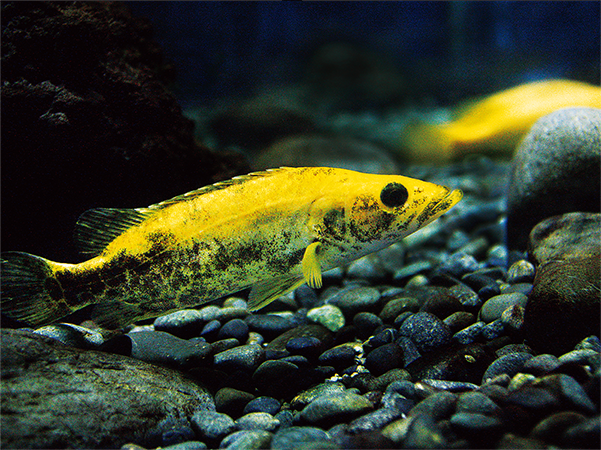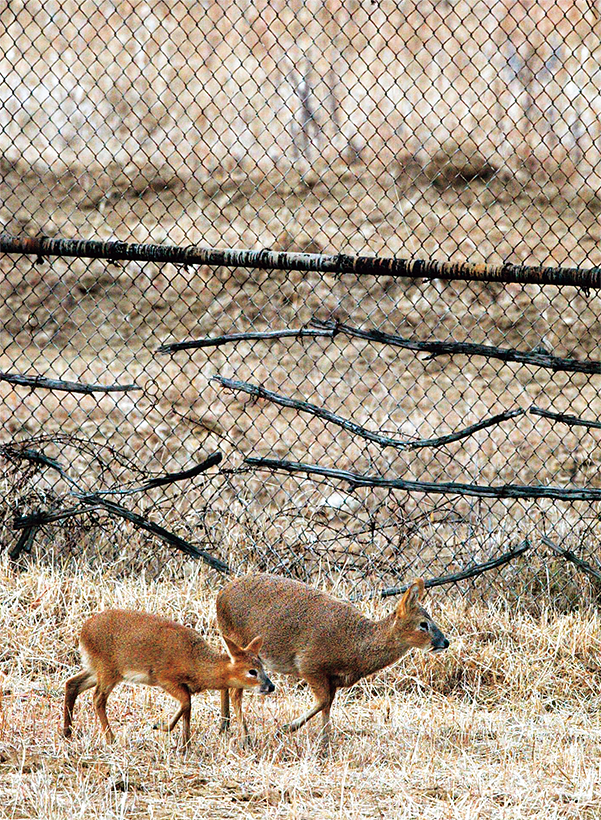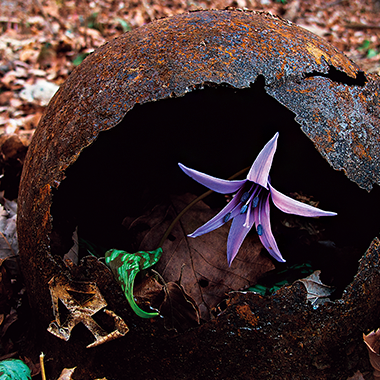A buffer zone between the two Koreas, the DMZ is part of a key ecosystem axis on the Korean Peninsula. This forbiddenstrip of land has been cut off from civilization for over 60 years since the end of the Korean War. Despite the continueddestruction of forests from military activities, wetlands have developed on the western side and temperate forestsflourish on the eastern side.
Taepung Observatory in Yeoncheon,Gyeonggi Province offers views of theImjin River meandering southwardthrough the DMZ from North Korea.
Entry into the DMZ is basically allowed for only a limited number of military personnel from boththe South and the North. Since the ceasefire in July 1953, only a handful of civilians have beenpermitted to step foot in the area. In the early 2000s, amid a growing mood of détente, the twoKoreas discussed plans to reconnect cross-border roads and rail lines, including the Gyeongui Line,from Seoul to Sinuiju, and the Donghae Line along the east coast. That’s when I had a chance to enterthe DMZ, on three occasions, as a member of a joint public-private survey team to conduct an environmentalimpact assessment of the zone, albeit on a very limited scale.
In 2006, I entered the DMZ again to take part in a forest environment survey under the sponsorship ofthe Korea Forest Service and the Defense Ministry. We walked close by the barbed wire fences along thesouthern limit line all the way from the mouth of the Imjin River in Paju, Gyeonggi Province, the westernend of the frontline, to Goseong, Gangwon Province, the eastern end. It was a tiring job that took twomonths. Each morning, we crossed the civilian control line to enter the DMZ and walked our daily permitteddistance along the south side of the Military Demarcation Line. There we found a mosaic of temperateforest ecosystems, forming a treasure trove of biodiversity, ranging from ordinary puddles to climaxforests.
Western Wetlands
It is the wetlands that form the most dynamic scenery in the western part of the DMZ. The bodiesof water in this area have turned into wetlands through a process of natural succession. Traces of oldpaddy levees can be seen here and there, in the midst of all this water in streams large and small, valleys,puddles, and reservoirs, creating a diverse landscape.

Golden mandarin fish, a designatednatural monument,swim in the upper reaches ofthe Bukhan River in HwacheonCounty, Gangwon Province, inthe DMZ.
The vast central western part of the DMZ used to be a rural area before the Korean War. The oldfarmlands lie along waterways. Over a long period of time, the abandoned rice paddies have turned intoa haven of wetland biodiversity, which sustains a variety of birds, fish, amphibians, reptiles, and a multitudeof insects. Walking along the barbed wire fences, we marveled at the diversity of sights presentedby the wetlands, formed on sites where no farming has been undertaken for decades. In winter, the wetlandsare home to all kinds of migratory birds, including red-crowned cranes and white-naped cranes.
One internationally protected species that lives in these wetlands is the water deer. These deer aresmaller and slenderer than other deer species. They look meek as they leisurely roam around themarshes or in quiet spots, yet they can jump with the agility of a cat.
The brooks and streams in the valleys of the DMZ, most of which originate in the North and flowinto the South, are as clean and clear as the waters we remember from pre-industrial days.
Thanksto a complete ban on all development and fishing, a variety of freshwater fish are swimming freely inthe waters here.In fact, fish are so abundantthat one could say the waters are“half water and half fish.” Though ottersare an endangered species, they are foundthroughout the DMZ, feeding on the fish soplentiful in the waterways.
Walking along the barbed wire fences, we marveled at the variety of sights presented by the wetlands,formed on sites where no farming has been undertaken for decades. In winter, the wetlands are hometo all kinds of migratory birds, including red-crowned cranes and white-naped cranes.

Water deer walk along thebarbed wire fence in the centralfrontline area of the DMZ.
Eastern Forests
The eastern end of the frontline is densewith forests. The valleys are deep and theslopes are steep. No forest fire spreadsvery fast or wide here. It is an environmentthat provides animals with a stable habitatand safe playground. Soldiers on duty oftenrun into endangered species like mountaingoats and musk deer. Since the 1970s,musk deer had all but vanished from sight on the Korean Peninsula, except for the DMZ. But their existence in areas outside the DMZ was confirmedin 2014. They are on the Red List of threatened species of the International Union for Conservationof Nature. Many other mammals, such as sables, flying squirrels, wildcats, and Asiatic black bears,also live in the DMZ. Amazingly, these animals are not afraid of humans. They say it’s because of theunspoken rule among soldiers stationed in the DMZ, who refrain from killing wild animals believing thatit will bring bad luck.
The natural forest areas in the DMZ, which extend over magnificent ridges and peaks, are thick withsuch trees as Mongolian oaks, white oaks, Oriental oaks, blackbirches, wild cherry trees, painted maples, and wild-walnut trees.About 30 indigenous plant species, including nodding lilies and diamondbluebells, also thrive here.
The nature and ecosystem of the DMZ are piquing the curiosityof many people. But an ecosystem survey has been conducted in amere 10 percent of the entire area, and it has been a long time sincethe last survey was completed. Many areas are still inaccessibledue to the numerous landmines. I look forward to the day when afoundation is laid for peace between the two Koreas, so that a fullscalesurvey can be conducted and the shroud of mystery liftedfrom the entire DMZ.
Migratory birds know noboundaries as they arrivein search of leftover grainin the Cheorwon Plains,where the harvest is over.

A dog’s-tooth violet growsthrough a crack in anabandoned, rusted combathelmet.
A SUMMARY LOOK ATTHE DMZ ECOSYSTEMThe forest ecosystem of the DMZ and vicinity isdivided into the western coastal area, central westerninland area, central eastern mountain area, and easterncoastal area, according to the National Institute ofForest Science of the Korea Forest Service.
■ The western coastal area has vast expanses ofbrackish water wetlands, including the estuaries ofthe Han River and the Imjin River, where freshwatermeets saltwater. Hills around 100 meters high standhere and there, and the fertile plains are suitable forfarming. Many endangered birds, such as black-facedspoonbills, white-naped cranes, and Chinese geese,live here.
■ The central western inland area includes YeoncheonCounty and the Cheorwon Plains, which arevolcanic lands near the Hantan River. The Imjin Riverand the Hantan River meander through this area,where red-crowned cranes and white-naped cranes,two internationally protected bird species, spend theirwinter.
■ The central eastern mountain area, lying nearthe Bukhan River between the Baekdu Daegan andHanbuk Jeongmaek mountain ranges, is surroundedby mountains over 1,000 meters high and covered withdense forests. Mountain goats and musk deer, naturalmonuments of Korea, inhabit these mountains.
■ Finally, the eastern coastal area sits east ofBaekdu Daegan, or the Great White Head Ridge,which runs through the Korean Peninsula. The areabetween Hyangno Peak and Mt. Geonbong has beendesignated a nature reserve.